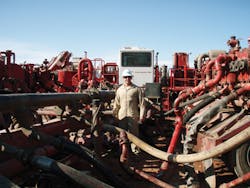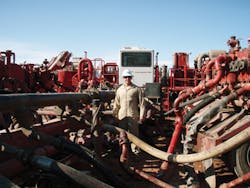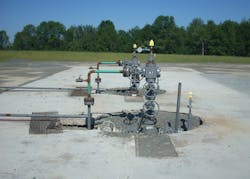Is Centralised Treatment the Way Forward?
With the already significant fracking industry set for further rapid expansion in the US, the demands on fresh water supplies are mounting, as is the need to process the large volumes of produced wastewater. Centralised treatment of wastewater is emerging as a viable solution for long-term efficiency in managing water sourcing and wastewater treatment in hydraulic fracturing.
Jeff Easton reports.
The number of hydraulic fracturing (fracking) shale oil and gas wells in the US, and worldwide, continues to increase. The Bakken Shale formation alone, located in North Dakota and Montana, is home to upwards of 15,000 hydraulic fracturing wellheads, with another 20,000 planned.
The US has vast reserves of oil and natural gas which now are commercially reachable as a result of advances in horizontal drilling and hydraulic fracturing technologies. But as more hydraulic fracturing wells come into operation, so does the stress on surface water and groundwater supplies from the withdrawal of large volumes of water used in the process – needing up to one million gallons (3,780 m3) of fresh water per wellhead to complete the fracking process alone.
Equally important is the growing volume of wastewater generated from fracking wells, requiring disposal or recycling. Up to 60% of the water injected into a wellhead during the fracking process will discharge back out of the well shortly thereafter, as flowback wastewater. Thereafter, and for the life of the wellhead, it will discharge up to 100,000 gallons (378 m3/day) of wastewater. This wastewater needs to be captured, and disposed of or recycled.
Because water is the base fluid and biggest component used in hydraulic fracturing, its importance remains a critical factor in the operation and economics of shale oil and gas production. But significant and growing water management challenges are impacting hydraulic fracturing.
Fresh water and wastewater operating procedures which have been in place since the late 1990s are experiencing increasingly stiffer governmental regulations on water availability and disposal limitations. These factors are prompting oil and gas executives to reassess their current water utilization activities regarding fracking, and adopt a more unified, and longer-range perspective on their water life-cycle management.
Solutions
One solution that promises a truly comprehensive approach to integrating all aspects of fresh water and wastewater management in shale oil and gas production, while optimising the utilisation of water resources throughout the entire lifecycle of well production, is a centralised approach to the treatment and reuse of wastewater.
Centralisation not only provides treatment and reuse of flowback wastewater from a large number of wellheads when the wells are fracked, but also provides treatment and reuse of the produced wastewaters for the long-term, full lifecycle of the wells – which represent the vast majority of wastewater flowing from wellheads.
Furthermore, a centralised system can more easily access and use alternative water sources, such as from municipal wastewater facilities, which otherwise would be highly unlikely to be accessed.
Inherently, wellheads providing shale oil and gas production are long-term processes, typically exceeding 20 year terms, but conventional solutions in play for handling fresh water resources and wastewater are geared towards the short-term.
Impounding wastewater for evaporation in surface ponds, trucking water over long distances to deep-well injection sites, and treating flowback wastewater for reuse at the wellhead are all short-term options which do not address critical long-term issues impacting of the industry – such as diminished water sources, increasing regulations limiting wastewater disposal, and growing safety and environmental concerns from government and the public.
The centralised wastewater management concept is gaining momentum. In North America, well over a dozen centralised wastewater treatment facilities servicing shale oil and gas drilling are now either up and producing, or in development.
Diminishing Options for Water Sourcing
Fresh water supplies for use in hydraulic fracturing are becoming more expensive harder to obtain.
Relatively recently, the Army Corps of Engineers mandated against the long-standing policy of acquisition of water from the Missouri River watershed for use in shale oil and gas fracturing. This diverted fracking operators to purchase pond and well water at higher rates from local landowners. Now these landowners are running out of water. The 2013 water usage in Bakken formation fracking wells is expected to reach six billion gallons (2.27 million m3). Today, water sourcing is the main fracking challenge in the Bakken.
In Texas, where hydraulic fracturing wells work the Eagle Ford, Barnett Shale or Permian Basin formations and deal with the constant threat of drought, fracking operators compete with farmers and ranchers for their share of fresh water. As with North Dakota, water sourcing is the main fracking challenge in Texas. In both of these areas, there does not exist an indefinite supply of water for expansion of hydraulic fracturing operations.
Even in Pennsylvania, and throughout the Marcellus and Utica Shale formations, where water is more accessible, with the increase in numbers of well sites water sourcing is becoming more tightly controlled. According to the Susquehanna River Basin Commission (SRBC), hydraulic fracturing a horizontal Marcellus well may use four to eight million gallons (15,150 m3 to 30,300 m3) of water, typically within about a one week period.
However, the Commission states, some Marcellus wells may need to be fractured several times over their productive life (typically five to twenty years, or more). These large water withdrawals may come from streams, rivers, privately-owned lakes and ponds, or groundwater, and could affect availability of nearby drinking water sources and other uses, increasing the potential for conflicts between water users.
Wastewater Disposal Limitations
Many fracturing wells operating in the Bakken formation in North Dakota and Montana, and those functioning in the Eagle Ford, Barnett Shale and Permian Basin formations in Texas, use surface ponds to store hydraulic fracturing fluids (flowback and produced wastewater) for evaporation, or until arrangements are made for disposal.
Almost 50% of the wastewater generated from hydraulic fracturing in these states is diverted and stored in surface ponds. Within the past 24 months however, Pennsylvania has completely eliminated the use of surface ponds for wastewater storage.
But the future use of surface ponds is sure to become more regulated. The EPA is currently evaluating industry practices and state requirements, and is considering the need for technical guidance on the design, operation, maintenance, and closure of surface ponds under the Resource Conservation and Recovery Act (RCRA) in order to minimise potential environmental impacts.
Deep-well injection
In many regions of the US, including Texas, North Dakota and Montana, deep-well underground injection is a popular method for the disposal of fracking fluids and other substances from shale oil and gas extraction operations. Pennsylvania however, outlawed the use of deep-well injection some time ago.
Fracking companies operating in Pennsylvania, desiring to deep-well inject their wastewater, must have it trucked to Ohio for deposition. This opens another set of potential issues relating to transporting large volumes of wastewater. Municipalities are concerned about the safety of high numbers of trucks traveling on rural roads and through small towns, and the safety implications for local residents. Another consideration is the impact of fleets of heavy trucks traveling on these roads.
To help offset this issue, some local governments in Pennsylvania require fracking companies to post bonds to cover road repair and maintenance. Issues with trucking wastewater from fracking wells to deep-well injection sites are not isolated to Pennsylvania.
The costs for hauling away wastewater for deep-well injection ranges between $3 and $7 per barrel ($0.35 to $0.85 per cubic metre). For a newly fraced well, the cost could reach $100,000 for transporting over 14,000 barrels (1,670 m3) of flowback – water levels produced from each basin, and indeed, each wellhead can vary. Plus, an additional potential 3400 barrels (405 cubic metres) each day of transported produced wastewater, at $20,000 per day.
To haul water off-site for disposal over the 20 year life of a hydraulic fracturing well-project, it was estimated to cost $160 million (includes trucking costs, water disposal costs and labour).
Wellhead Wastewater Treatment
Wastewater associated with shale oil and gas extraction can contain high levels of total dissolved solids (TDS), fracturing fluid additives, total suspended solids (TSS), hardness compounds, metals, oil and gas, bacteria and bacteria disinfection agents, and naturally occurring radioactive materials.
These contaminants are partially a combination of chemicals and agents inserted deep into the well (9,000 feet and deeper) which facilitate fracking by modifying the water chemistry to increase viscosity, carry more sand and improve conductivity. Effectively, the fracking process is pushing the water down into the rock formation, trying to wedge the rock cracks open. The sand fills in between the cracks that the hydraulic fluid has propped open.
Once the fracking is done, much of the water comes back up the well as flowback wastewater. Along with it comes bacteria and characteristics of the geologic formation, including minerals, radioactive materials and oil and gas.
Some drilling operators elect to re-use a portion of the wastewater to replace and/or supplement fresh water in formulating fracturing fluid for a future well or re-fracturing the same well. Re-use of shale oil and gas wastewater is, in part, dependent on the levels of pollutants in the wastewater and the proximity of other fracturing sites that might re-use the wastewater. This practice has the potential to reduce discharges to surface ponds, minimise underground injection of wastewater, and conserve and reuse water resources.
Mobile solutions to treat wastewater at the wellhead enable recycling and reuse of flowback without the need for storing wastewater in surface ponds on-site, or for trucking flowback wastewater for disposal at off-site deep-well injection locations. Recycled wastewater is treated specifically for a different well site frac. The treatment is customised for the geology of that specified well site.
The drawback of wellhead mobile solutions is that they do not provide continuous processing to handle produced wastewaters, which would need to be processed for potentially 20 years following fracking.
Centralised Water Management
Centralised treatment of wastewater is emerging as a viable solution for long-term efficiency in managing water sourcing and wastewater treatment in hydraulic fracturing. Centralised treatment facilities handle both the flowback wastewater and produced wastewater from oil and gas wells within a region, at a radius of 40 to 50 miles. Pipelines connect all wellheads directly with the central treatment plant.
Wastewater received by the plant is identified as originating from a specific well. The targeted usage requirements for that wastewater are specified and the wastewater is then processed to meet that usage. Once processed, the wastewater is then piped directly to the targeted well site.
Central wastewater treatment facilities processes can include:
• Primary three-phase separation to remove dissolved natural gas, floating gel, oil, sand and suspended solids, followed by storage for equalisation of chemical composition and flow
• Secondary separation utilising dissolved air or gas flotation for removal of a wide variety of contaminants including polymers, oils and suspended solids. Bactericide is added to control bacterial growth
• Removal of metals by precipitation, and removal of salts by reverse osmosis
• Sludge management for dewatering collected solids.
Such centralised plants can be integrated with alternative sources of water to supplement fresh water needs for fracking, such as from abandoned mines, storm water control basins, municipal treatment plant effluent, and power plant cooling water.
Such initiatives are in alignment with mandates from Pennsylvania's SRBC and its Department of Environmental Protection, which emphasise future trends in water use for oil and gas drilling should represent more reuse of water for fracking, and more use of other waters, such as treated wastewater and acidic mine drainage, in the hydraulic fracturing process.
Critical importance
The development of an integrated infrastructure for water management in shale oil and gas production has lagged behind improvements in drilling technology, which have been successful in spearheading this industry into recent national prominence.
In the face of increasingly constricting traditional water sourcing options and tightening wastewater treatment regulations, the need for an industry initiative to develop this infrastructure network to deal with these water related issues is of critical importance if oil and gas producers are to effectively manage their frack well operations and maximise profits.
Centralised water management allows wastewater processing to be implemented on an economy of scale that has not before been realised in the shale oil and gas production industry.
Reduced capital costs for treatment and distribution systems, lower operating costs, and a more favourable position to garner public and governmental acceptance are the key benefits of this centralised approach to water management.
Jeff Easton is principal process engineer at WesTech Engineering, email: [email protected].




